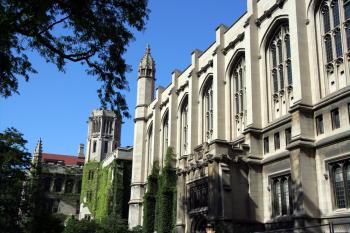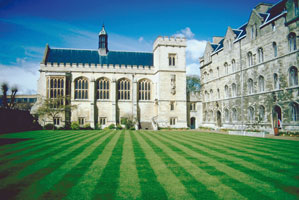find your perfect postgrad program
Search our Database of 30,000 Courses
Universities in the UK
There are currently around 130 universities in the United Kingdom. From millennia old to brand new, universities in the UK vary on everything from age to size to prestige. With such diversity, it’s not an overstatement to say that there is a university for everyone in the UK. With many of the world’s top universities both in terms of graduate prospects and QS World Rankings, the UK has so much to offer within its higher education system.
The problem is that with so many universities, it hard to start comparing them straight away and sometimes you need to dig a bit deeper to find out more about them and get the full lowdown. Most universities are informally categorised by their age and nicknames, but the unofficial categories used in the press like ‘Red Brick’ and ‘Plate Glass’ often mean nothing to international students.
Universities formed around the same time often are similar in style and prestige, so a lot can be learned from looking at what group your university of choice belongs. To give you the low down on what all these terms mean, here is a quick chronological guide to universities and their groupings in the UK.
Find your PERFECT POSTGRAD PROGRAM
 Ancient Universities
Ancient Universities
There are a lot of arguments about what universities should be within the ‘ancient’ category because many universities have been centres of learning for over a thousand years without officially being called a university. However, the list can usually be narrowed to those institutions that have formally been universities since medieval times. These are the universities of Oxford, Cambridge, St Andrews, Glasgow, Aberdeen and Edinburgh; whose dates of foundation range from c. 1096 to 1582. Read our section on the Universities of Oxford and Cambridge.
Nineteenth Century Universities
Many centres of learning in the UK were not formalised as universities, so during the 19th century a number of them were granted charters or formalised by Acts of Parliament so that they could officially use the title of university. Because of this, many universities officially founded in the 19th century like Durham University and several of the constituent colleges of the University of London are actually much older than they seem. This means that institutions like Durham, University College London and Kings College London enjoy much of the prestige of ‘Ancient Universities’ and often have more in common with them than with the chronologically closer ‘Red Brick’ universities.
Red Brick or Civic Universities
Often called ‘Red Brick’ universities due to their distinctive turn-of-the-century building style, many institutions that were formally civic learning or engineering colleges became universities around the turn of the 20th century. Red Brick universities were generally universities situated in the middle of large industrial cities (for example what is now known as the University of Manchester and the University of Liverpool).
Plate Glass or 1960s Universities
When the UK government commissioned the Robbins Report on Higher Education, it declared on completion in 1963 that there were too few universities in the UK. This opened the way for the creation of a whole new slew of universities. Called the Plate Glass group, again because of their architectural style, these universities were often purpose-built campus universities whose facilities were lauded at the time. The fate of the group has been mixed, some like the University of Warwick are among the most prestigious in the UK, while others coast in the middle of the league tables.
New or Polytechnic Universities
In 1992 the way was opened again for the creation of new universities, which lead to many ‘polytechnic’ colleges gaining university status. While the new universities do not have the prestige and the rankings of their older counterparts, they are quickly growing and competing with the older institutions as they have new facilities and more modern outlook.
'New' New Universities
Recently there has been a trend for establishing new universities in the UK. In many cases these are former higher education institutions that have become full-status universities following a recent change in the eligibility criteria as the UK government has dropped the minimum student numbers for an institution to qualify for university status from 4,000 students to 1,000 students. These can offer a very personalised postgrad experience among a small and nurturing student cohort.
So that’s a basic guide to the types of university in the UK, however confusingly there a probably a few more names you should know. Many universities belong to official organisations which they use to lobby government over research funding, but these organisations have now become famous in their own right. These are:
 Russell Group: The Russell Group is an organisation of prestigious universities that are often regarded as the ‘best’ in the UK. Its members consist of mainly the ancient universities and 19th century universities, with a few of the larger civic universities. While many use the term Russell Group in a similar way to the ‘Ivy League’ in the US, the Russell Group doesn’t have quite the same name recognition as that famous US league. Read our blog on the Russell Group for a greater insight.
Russell Group: The Russell Group is an organisation of prestigious universities that are often regarded as the ‘best’ in the UK. Its members consist of mainly the ancient universities and 19th century universities, with a few of the larger civic universities. While many use the term Russell Group in a similar way to the ‘Ivy League’ in the US, the Russell Group doesn’t have quite the same name recognition as that famous US league. Read our blog on the Russell Group for a greater insight.
1994 Group: The 1994 group tends to represent smaller, research-intensive and often campus-based universities. While the 1994 group contains many of the top universities in the country, it is often seen as containing slightly less impressive institutions than the Russell Group.
Million+: Formerly known as the Coalition of Modern Universities, as that original name implies this organisation represents most of the former polytechnic universities.
Find your PERFECT POSTGRAD PROGRAMRelated articles
A Definitive Guide To Studying A Masters In The UK
What Is A New University & Why Should You Choose One?

